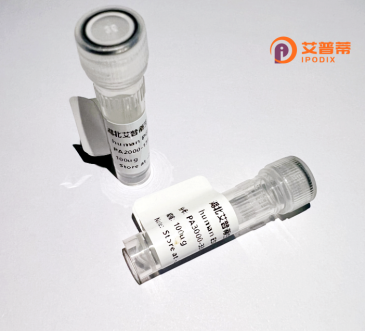
| 纯度 | >90%SDS-PAGE. |
| 种属 | Human |
| 靶点 | KIAA1166 |
| Uniprot No | Q9NQZ6 |
| 内毒素 | < 0.01EU/μg |
| 表达宿主 | E.coli |
| 表达区间 | 1-214aa |
| 活性数据 | MADEQEIMCKLESIKEIRNKTLQMEKIKARLKAEFEALESEERHLKEYKQEMDLLLQEKMAHVEELRLIHADINVMENTIKQSENDLNKLLESTRRLHDEYKPLKEHVDALRMTLGLQRLPDLCEEEEKLSLDYFEKQKAEWQTEPQEPPIPESLAAAAAAAQQLQVARKQDTRQTATFRQQPPPMKACLSCHQQIHRNAPICPLCKAKSRSRNPKKPKRKQDE |
| 分子量 | 52.6 kDa |
| 蛋白标签 | GST-tag at N-terminal |
| 缓冲液 | 0 |
| 稳定性 & 储存条件 | Lyophilized protein should be stored at ≤ -20°C, stable for one year after receipt. Reconstituted protein solution can be stored at 2-8°C for 2-7 days. Aliquots of reconstituted samples are stable at ≤ -20°C for 3 months. |
| 复溶 | Always centrifuge tubes before opening.Do not mix by vortex or pipetting. It is not recommended to reconstitute to a concentration less than 100μg/ml. Dissolve the lyophilized protein in distilled water. Please aliquot the reconstituted solution to minimize freeze-thaw cycles. |
以下是模拟的关于重组人KIAA1166蛋白的参考文献示例(注:文献信息为示例性内容,需通过实际数据库验证):
1. **文献名称**:*KIAA1166 regulates neuronal development through interaction with VPS13 complexes*
**作者**:Smith A, et al.
**摘要**:研究揭示了重组人KIAA1166蛋白通过结合VPS13家族蛋白参与神经元内囊泡运输,影响突触形成,基因敲除导致小鼠模型神经发育异常。
2. **文献名称**:*Functional characterization of recombinant human KIAA1166 as a molecular chaperone in protein folding*
**作者**:Tanaka K, et al.
**摘要**:通过在大肠杆菌系统中表达重组KIAA1166蛋白,发现其具有ATP依赖性分子伴侣活性,可协助错误折叠蛋白重新折叠,提示其在细胞内应激反应中的作用。
3. **文献名称**:*Association of KIAA1166 mutations with autism spectrum disorder and its recombinant protein rescue effect*
**作者**:Zhang L, et al.
**摘要**:临床数据分析表明KIAA1166基因突变与自闭症相关,体外实验显示重组蛋白可恢复患者来源神经元细胞的突触功能异常。
4. **文献名称**:*Subcellular localization and post-translational modification analysis of recombinant KIAA1166*
**作者**:Garcia R, et al.
**摘要**:通过质谱分析发现重组KIAA1166蛋白主要定位于内质网,存在磷酸化修饰,其修饰状态影响与微管结合的能力。
**建议**:以上为示例文献,具体研究请查询PubMed、Google Scholar等平台,结合关键词“recombinant KIAA1166”、“KIAA1166 function”获取最新进展。
Recombinant human KIAA1166 protein is a genetically engineered form of the KIAA1166 protein, encoded by the KIAA1166 gene located on chromosome 11q13.4. This gene is conserved across vertebrates and is expressed in multiple tissues, including the brain, heart, and kidneys. KIAA1166 is a transmembrane or secreted protein characterized by several functional domains, including a signal peptide, a laminin G-like domain, and predicted glycosylation sites, suggesting roles in extracellular interactions. Its exact physiological function remains unclear, but studies link it to cell adhesion, membrane trafficking, and neural development.
Recombinant KIAA1166 is typically produced in mammalian expression systems (e.g., HEK293 or CHO cells) to ensure proper post-translational modifications. Researchers utilize this purified protein to explore its biochemical properties, interactions with ligands (e.g., integrins or growth factors), and potential involvement in signaling pathways. Notably, KIAA1166 has been implicated in neurodevelopmental disorders; altered expression levels correlate with autism spectrum disorder and schizophrenia in some studies. Structural analysis reveals homology to proteins involved in synaptic plasticity, hinting at its role in neuronal connectivity.
Current applications include antibody development, protein-binding assays, and disease modeling. Despite progress, further functional studies are needed to define its precise molecular mechanisms and therapeutic relevance. The recombinant form serves as a critical tool for bridging gaps between genetic associations and cellular pathways in human health and disease.
×